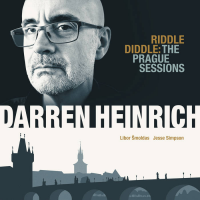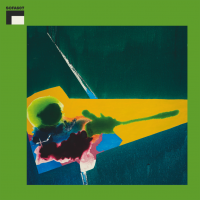Home » Jazz Articles » Album Review » Mary Halvorson: Code Girl
Mary Halvorson: Code Girl
Seen in this light, it is really not that surprising to encounter Halvorson's latest project, a double-CD release from a new group, Code Girl, which is perhaps best described as avant-jazz-indie rock. The "rhythm section" of the group consists of Halvorson's long-standing colleagues drummer Tomas Fujiwara and bassist Michael Formanek, who both play with her in their trio Thumbscrew. They are joined by vocalist Amirtha Kidambi, a remarkably creative and adventurous musician in her own right, whose album Holy Science (Northern Spy, 2016) by her band the Elder Ones was a pleasant surprise, fusing Indian classical and drone music with the spirit of free jazz. The group is completed by trumpeter Ambrose Akinmusire, a veteran of many genre-straddling projects, including work with Steve Coleman and Vijay Iyer, before becoming a more well-known commodity in recent years.
All the compositions on Code Girl are Halvorson's, and they bear her imprint—well-designed structures and striking harmonies, with enough openness to allow spontaneity and collaboration to emerge organically with her partners. Halvorson also penned the lyrics for the record. But Kidambi's versatility as a vocalist goes far beyond her ability to deliver a lyric; her note-bending leaps and bursts of ecstatic intensity allow her to contribute to the music as an equal, the instrument of her voice becoming essential to interpreting Halvorson's music; for this reason her wordless vocalizations are often her most compelling moments on the album. The fluidity of her approach is ideal for Halvorson's compositions, as she can follow Halvorson's intricate lines with aplomb, but without the sense that she is confined by them; she's always seeking paths to freedom within the parameters of the piece, something that characterizes the contributions of all five players. Akinmusire similarly finds plenty of outlets for impassioned playing here, either by tracing the contours of Halvorson's melodies or by utilizing more abstract techniques.
With fourteen pieces and almost 90 minutes of music, there's a lot to take in, although most of the pieces run for between five and seven minutes, allowing Halvorson's well- built pieces to develop their ideas without overstaying their welcome. The format allows for Halvorson's tuneful side to emerge even more prominently than usual, but there's nothing cloying or facile about these melodies. The opener, "My Mind I Find in Time" sees Halvorson introducing a deceptively simple looped passage that could pass initially for an Afrobeat riff, before settling into a steady groove around a folk-like melody sung by Kidambi with a winsome ostinato accompaniment from Halvorson and some lovely counterpoint by Akinmusire. But as Kidambi alternates between wordless expressions and Halvorson's poetic phrases, the band builds in intensity, Formanek and Fujiwara gradually expanding the unsettling reach of the song; and during a vigorous Akinmusire solo, the rock inflections become more pronounced and assertive, Halvorson's trademark bent-notes emerging to put her unmistakable stamp on the piece. And that's just the first track, a tightly-wound, potent melding of rock and jazz idioms with a character all its own.
Other pieces, like "Possibility of Lightning," possess Halvorson's signature labyrinthine lines, navigated skillfully by Kidambi and Akinmusire, with Fujiwara and Formanek playing with the tempo, whether surging behind Halvorson's energetic solo or by tightening or releasing the tension under Akinmusire and Kidambi. And then there's the hard-hitting onslaught of "In the Second Before," where Akinmusire brings some of his most rough-edged, out-leaning playing on the album, right before the band explodes with its heaviest intensity.
Despite the rock sensibility that permeates the record, there's too much creativity and imagination present for the music to risk becoming monotonous or constricting. This is why the longer pieces, like "Storm Cloud" or "The Unexpected Natural Phenomenon" may be the best windows into the group's distinctive sound. They offer substantial room for exploration; tunes emerge at first plainly, but they inevitably evolve as the band digs into them, Kidambi's vocals heading into the stratosphere or Halvorson's winding phrases shadowed or commented upon by Formanek and Fujiwara, with Akinmusire also a pivotal part of the conversation, as the band simply goes where the music leads.
Halvorson has always excelled at balancing form and freedom, and nowhere is that more evident than in the music on Code Girl. This is another bold step in Halvorson's continued evolution as a musician, and she is fortunate to have just the right ensemble for such an ambitious and multifaceted project.
Track Listing
My Mind I Find in Time; Possibility of Lightning; Storm Cloud; Pretty Mountain; Off the Record; In the Second Before; Accurate Hit; The Beast; The Unexpected Natural Phenomenon; Thunderhead; And; Deepest Similar; Armory Beams; Drop the Needle.
Personnel
Mary Halvorson
guitarMary Halvorson: guitar; Amirtha Kidambi: voice; Ambrose Akinmusire: trumpet; Michael Formanek: bass; Tomas Fujiwara: drums.
Album information
Title: Code Girl | Year Released: 2018 | Record Label: Firehouse 12 Records
Tags
PREVIOUS / NEXT
Mary Halvorson Concerts
Support All About Jazz
 All About Jazz has been a pillar of jazz since 1995, championing it as an art form and, more importantly, supporting the musicians who make it. Our enduring commitment has made "AAJ" one of the most culturally important websites of its kind, read by hundreds of thousands of fans, musicians and industry figures every month.
All About Jazz has been a pillar of jazz since 1995, championing it as an art form and, more importantly, supporting the musicians who make it. Our enduring commitment has made "AAJ" one of the most culturally important websites of its kind, read by hundreds of thousands of fans, musicians and industry figures every month.





















